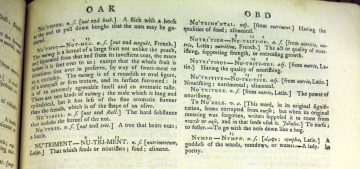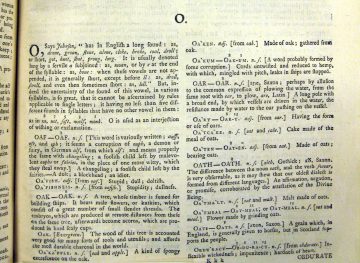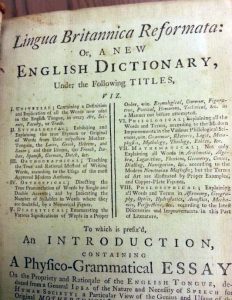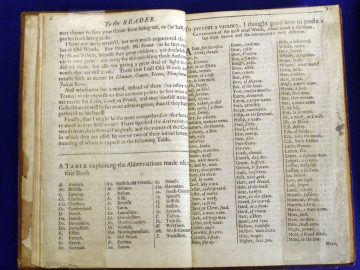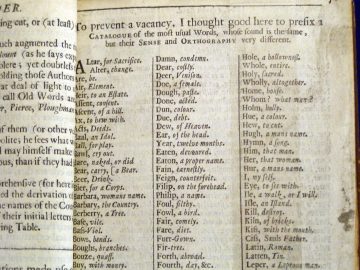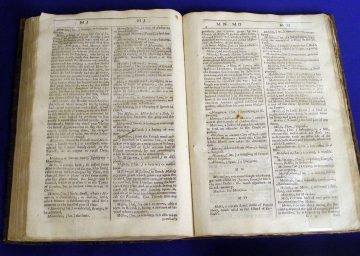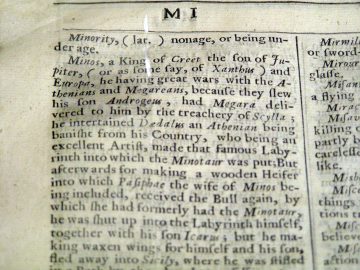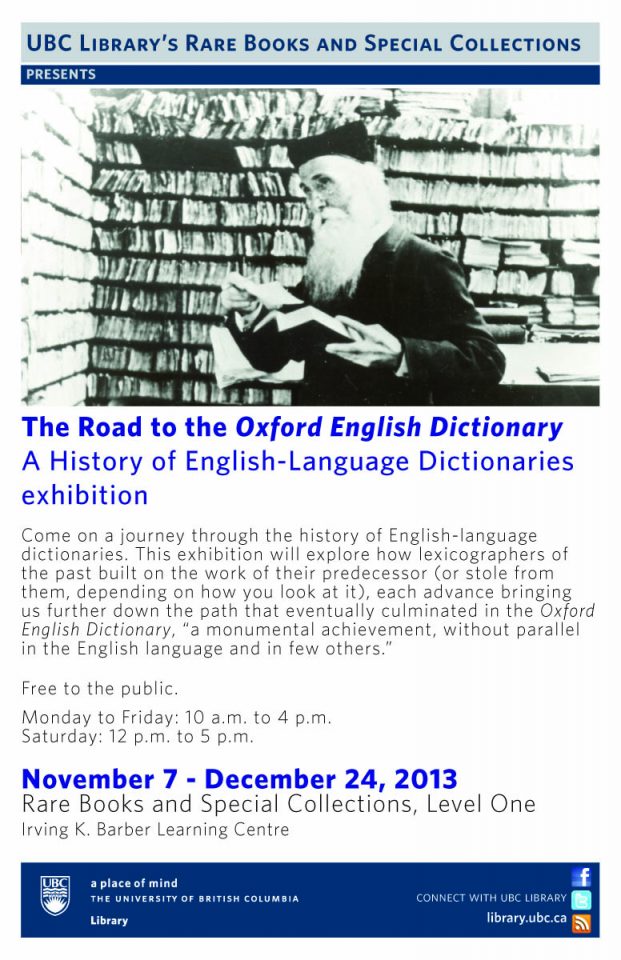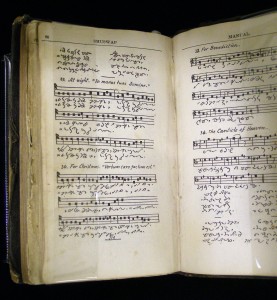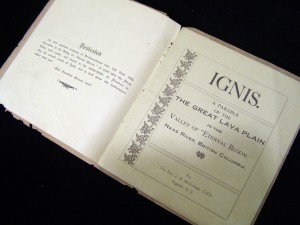“One of London’s most despised, drunken, and morally degenerate hack writers…”
Posted on February 28, 2017 @2:51 pm by cshriver
For this week’s student dictionary report from the course English 320: History of the English Language…a tale of a particularly roguish lexicographer:
Kenrick, William. A New Dictionary of the English Language. London: Printed for J. and F. Rivington, W. Johnston, T. Longman, and T. Cadell, 1773. PE25 .R62 V. 206
Writer William Kenrick was born in 1725 in Hertfordshire, England. In his literary career, Kenrick began writing short pamphlets and articles for the monthly journal The Kapelion. He was also a self-proclaimed but unsuccessful satirist who enjoyed mocking other writers in his work. He took pleasure in his victims’ rebuttals and gladly wrote his own replies to himself when others ignored his insults. Though he delighted in attacking his peers in print and often wrote with animosity, Kenrick was a rather jovial character in person, though a pest to his colleagues. He has been described as “one of London’s most despised, drunken, and morally degenerate hack writers in the later eighteenth century” (Fussell).
Though his literary style was impressive, Kenrick could not attain the respected status of many of his peers. James Boswell noted that he “wrote with so little regard to decency and principles, and decorum, and in so hasty a manner, that his reputation was neither extensive nor lasting” (Boswell). Kenrick repeatedly condemned the work of Samuel Johnson, evoking an academic conflict between the two writers. Despite identifying the flaws of Johnson’s publications, Kenrick used much of Johnson’s work regarding pronunciation guides to include in his New Dictionary of the English Language in 1773. In many cases, the extractions were reproduced without changes. He also pursued editing and publishing endeavors and became the editor-in-chief for the London Review of English and Foreign Literature (Rogers and Rizzo). In his final years, Kenrick remarried twice and spent time in Fleet prison for debt. He died of unidentifiable causes in 1779.
As a final attempt to antagonize Samuel Johnson, Kenrick wrote A New Dictionary of the English Language, published in London in 1773. The new dictionary most notably introduced a new system of guiding pronunciation that includes numbers and accents to represent the pronunciation and stressed syllables of words. Thomas Sheridan developed but had not yet published this scheme, so Kenrick once again plagiarized to gain success and insult his peers. The dictionary also includes the section “Rhetorical Grammar,” which was published in London and Philadelphia in 1784. This section analyzes the various grammars and uses of the English language. The entries in this dictionary have similarities to modern English dictionaries, including etymological information and the aforementioned phonetic guide, though Kenrick occasionally includes biased witticisms to illustrate certain terms. Though some of the lexicon has changed in present day English based on context and modern technologies, this dictionary well represents a core vocabulary that applies to both the 18th century and the present.
— Jessica Shaw (English 320: History of the English Language, 2012-2013)
No Comments
Thanks for joining us!
Posted on February 28, 2017 @2:53 pm by cshriver
Many thanks to everyone who attended Professor Dollinger’s talk last Friday on the past, present, and possible future(s) of the Oxford English Dictionary. It was entertaining, insightful, and provided lots of food for thought. Even if you weren’t able to make it to the talk, the related exhibition, The Road to the OED: A History of English-Language Dictionaries, will be on display in Rare Books and Special Collections until December 24. We hope you stop by!
Now for this week’s student dictionary report from the course English 320: History of the English Language.
Martin, Benjamin. Lingua Britannica Reformata, or, A New English Dictionary. London: Printed for J. Hodges [etc.], 1749. PE25 .R62 V. 234
Benjamin Martin (bap. 1705, d. 1782), the author of Lingua Britannica Reformata, or, A New English Dictionary (1749), was a man known for being “remarkable for his successful versatility” (Millburn 2004). “In an age when it was still possible for one man to comprehend virtually all branches of science,” John Millburn writes in his biography of Martin, “he was the supreme non-specialist” (Millburn 1976, 2). Indeed, Martin was not only a lexicographer, but also a teacher, lecturer, eyeglass-specialist, and microscope-maker. In fact, for most of his life, his main occupation was lecturing on Newtonian physics. He began writing books with the intention of lowering the price of books, as he wanted to ensure that people could educate themselves through reading. Having been born the son of a farmer, books were his gateway to knowledge, and apparently it was through extensive reading that Martin came to understand the various subjects he later taught when he opened up a school in Sussex with his wife (Martin 2004).
Lingua Britannica Reformata is but one of his many publications, and it was published twice, once in 1749 and again in 1754 (Millburn 2004). He wrote it with several aims in mind, which are listed at the beginning of the dictionary. A particularly interesting aim was that of UNIVERSALITY. By this, Martin meant that he intended to achieve a “just Mean” between “useless and obsolete Words” and “those which are useful and necessary” (Martin 1749, iv) – in other words, fairly represent words that are commonly used in English language, regardless of their potentially lower prestige. He believed in the importance of accurately reflecting the English language of his time as it was most commonly used, and did not share the same concern for preserving antique forms and words that other lexicographers may have had. Nevertheless, he understood the importance of linguistic history, and he spent a great deal of effort on etymology in both the preface to the dictionary and in the actual entries themselves. He argued that knowing a word’s etymology was crucial for a clearer understanding of the word’s signification, and thus provided Greek, Hebrew, French, or Latin roots for words where he could, occasionally glossing the meaning of the root word.
An interesting insert in the dictionary that is worth looking at is the collection of geometrical and astronomical diagrams that he included in the back of the dictionary, likely because of his own expertise in those subjects. Martin was undoubtedly a fascinating figure of his time, and continues to be remembered for being an excellent polymath.
— Kerong Lin (English 320: History of the English Language, 2012-2013)
Millburn, John R. Benjamin Martin: author, instrument-maker, and country showman. Leyden: Noordhoff International Pub, 1976.
Millburn, John R. “Martin, Benjamin (bap. 1705, d. 1782).” John R. Millburn In Oxford Dictionary of National Biography, online ed., edited by Lawrence Goldman. Oxford: OUP. http://www.oxforddnb.com.ezproxy.library.ubc.ca/view/article/18175 (accessed April 4, 2013)
No CommentsThe OED and Miley Cyrus?!
Posted on February 28, 2017 @2:54 pm by cshriver
So what does Miley have to do with the Oxford English Dictionary, you may ask? If anyone can tell us, it’s UBC’s Professor Stefan Dollinger. Professor Dollinger will be giving a talk this Friday, November 15, at 12 p.m. entitled:
The Oxford English Dictionary, the Grimm Brothers, and Miley Cyrus
On the Changing Expectations of the OED: Past, Present and (Possible) Futures
In addition to contextualizing the origins of the OED, Professor Dollinger will consider whether Miley Cyrus may one day popularize concepts, words, and phrases that could find entry into the OED, whether such colloquialization has a place in this prestigious work, and how we might conceive of the English-language dictionary in the 21st century.
The talk will be the Dodson Room on level three of the Irving K. Barber Learning Centre at UBC. Bring your lunch and join us for what promises to be a fascinating talk!
Now for this week’s student dictionary report from the course English 320: History of the English Language.
Coles, Elisha. An English Dictionary. London: Printed for Peter Parker, 1685. PE25 .R62 V. 102
Dictionaries play an essential role in the history of English lexicography. They keep not only a record of our vocabulary, but also a record of our culture and our beliefs. An English Dictionary Explaining the Difficult Terms by Elisha Coles is a wonderful dictionary that offers contemporary readers a glance into the past and at the changes in the English language.
Coles was born around 1640 and died in 1680. He was a lexicographer, a stenographer, and a schoolmaster in London. He is best-known for his dictionary. There are a total of 13 editions of the dictionary published between in 1676 and 1732. Since 1732, it has been reprinted many times (the most recent reprint is in 2011). Between 1500 and 1650, there was an influx of new words borrowed into English from Latin or Greek, or distant countries that English traders had visited, leading to a growing need for English dictionaries as the English lexicon became difficult for many English-speakers. Nonetheless, the earliest monolingual dictionaries were not general-English-language dictionaries, but “hard word” dictionaries that explained difficult and foreign words. Although the title contains “difficult terms,” this was the first dictionary to shift towards becoming a general-purpose dictionary by including a broader variety of materials, such as canting terms (also called criminal slang).
As Coles’ dictionary is one of the earliest monolingual English dictionaries, it is not surprising that it does not have many of the features that contemporary dictionaries do (e.g., part-of-speech, subject label). Nevertheless, it has many noteworthy features not found in modern dictionaries. For example, it includes a catalogue of homophones from which we can see evidence of sound change (e.g., “are,” “air,” and “heir” are listed together, suggesting that “are” may have sounded like “air”). Also, on the last page, there are seven tables of measure (e.g., a table of Troy-weight, of Aver du pois Weight), exemplifying the intensity of language-mixture and culture-mixture during the 17th century as a French table of weight is included in a monolingual English dictionary. The tables of measure are different from today’s measures as well (e.g., “13 years, 1 day and 6 hours” makes “1 year very near”). Furthermore, the dictionary illustrates a period of transition in orthography (i.e., its own content alternates between using “s” and long “s,” and –t and –ed past tense inflection). Overall, although An English Dictionary does not have many of the dictionary features found in modern dictionaries, it has its own unique features which reflect the interests and concepts of its time. Providing a glimpse into the past, it is a valuable dictionary not only for the 17th century but also for the 21st century and probably for many centuries to come.
— Skylet Yu (English 320: History of the English Language, 2012-2013)
Time to hit the road…The Road to the OED!
Posted on February 28, 2017 @2:55 pm by cshriver
A new exhibition, The Road to the OED: A History of English-Language Dictionaries, is now up in Rare Books and Special Collections!
This exhibition features work done by seven students from the course English 320: History of the English Language. For this class, Professor Laurel Brinton asked each student to select one dictionary from the H. Rocke Robertson Collection of Dictionaries, to research the author of the dictionary, and to report on the features of the dictionary in the context of the history of English lexicography–the activity or occupation of compiling dictionaries. We were delighted to include these reports and the dictionaries that inspired them in in our exhibition, and each week, we will be posting one student report and photos of the dictionary on our blog. We hope this inspires you to stop by to see the rest of the exhibition, or simply to take a little extra time to appreciate the humble dictionary the next time you look up a word!
You can visit the exhibition at Rare Books and Special Collections on the first floor of the Irving K. Barber Learning Center from 10 a.m.-4 p.m., Monday-Friday, and from 12-5 p.m. on Saturdays until December 24, 2013.
Phillips, Edward. The New World of English Words: or, A General Dictionary. London: Printed by E. Tyler, for Nath. Brooke at the Sign of the Angel in Cornhill, 1658. PE25 .R62 V. 260
First published in 1658, Edward Phillips’ New World of English Words has the distinction of being the first folio English dictionary. In terms of content, it is firmly placed in the tradition of dictionaries of “hard words” initiated with Robert Cawdrey’s A Table Alphabeticall of 1604. As the title states, the work contains “the Interpretations of such hard words as are derived from other Languages; whether Hebrew, Arabick, Syriack, Greek, Latin, Italian, French, Spanish, British, Dutch, Saxon, &c. their Etymologies and perfect Definitions.” Phillips then goes on to offer a long list of specialized disciplines and sciences whose terms will be explained in the dictionary, including “Theologie,” “Physiognomy,” “Jewelling,” and “Husbandry,” and adds that the reader will also find “The significations of Proper Names, Mythology, and Poetical Fictions, Historical Relations, Geographical Descriptions of most Countries and Cities of the World.” As with all dictionaries of this kind, the main difference between the New World and modern lexicographical works is the conspicuous absence of common, everyday words. This was standard practice at the time, and would only begin to change with the publication of Samuel Johnson’s A Dictionary of the English Language in 1755.
Entries in the New World are extremely straightforward: the headword appears in italics, and the definition follows. What Phillips calls the “etymology” is a parenthetical indication of the language of origin which occurs between the headword and the definition in most but not all entries. The style and the content of the definitions themselves are fairly inconsistent. A definition can range from one word, like “exalted” for Mary, to a list of synonyms, like “weaknesse, indisposednesse” for Infirmity, to a short explanation, like “a calling aside, a drawing apart” for Sevocation, to what amount to brief encyclopaedic entries, like that for Minos. If we compare these entries with those in modern dictionaries we notice again that much is lacking. Phillips does not provide a pronunciation guide, for example, a feature which is particularly missed in a dictionary composed almost exclusively of rare words, usually of foreign origin. Neither is the part of speech indicated, though most words—again, as with most “hard words” dictionaries—are either nouns or verbs. The etymological aspect, as has been said, is extremely deficient, and, in fact, does not even meet the standard set by Phillips’ own definition of the word as “a true derivation of words from their first Original.” Lastly, as we would expect, Phillips does not make use of illustrative quotations, nor does he seem at all to be interested in usage, as evidenced by the fact that he makes use of a small group of “learned Gentlemen and Artists,” which he lists at the beginning of the work, as sole authorities for his definitions.
Though the New World was a popular and successful dictionary, it is unlikely that it made any impact on the development of the discipline of lexicography, save perhaps as being part of that tradition which writers such as Johnson were trying to improve upon. Phillips’ was an unoriginal work, both in design and in content—he plagiarized a considerable number of his definitions from Thomas Blount’s earlier Glossographia—and it is safe to say that it was partly with the New World in mind that the Earl of Chesterfield declared in 1754 that “our dictionaries at present [are] more properly what our neighbours the Dutch and the German call theirs, word-books, than dictionaries in the superior sense of that title.”
— Javier Ibáñez (English 320: History of the English Language, 2012-2013)
No CommentsThe Road to the OED: A History of English-Language Dictionaries
Posted on February 28, 2017 @2:54 pm by cshriver
Rare Books and Special Collections at UBC Library announces an upcoming exhibition!
The Road to the OED: A History of English-Language Dictionaries
Join Rare Books and Special Collections on a journey through the history of English-language dictionaries. This exhibition will explore how lexicographers of the past built on the work of their predecessor (or stole from them, depending on how you look at it), each advance bringing us further down the path that eventually culminated in the Oxford English Dictionary, “a monumental achievement, without parallel in the English language and in few others.”
November 7—December 24, 2013
The exhibition will be open Monday through Friday, 10 a.m. to 4 p.m., and Saturday, 12 p.m. to 5 p.m., at Rare Books and Special Collections on the first floor of the Irving K. Barber Learning Centre.
Free and open to the public.
For more information, please contact Rare Books and Special Collections at 604 822-2521 or rare.books@ubc.ca.
2 CommentsCharles van Sandwyk and the Children’s Literary Tradition
Posted on October 9, 2013 @11:37 am by kalsbeek
UBC Library’s Rare Books and Special Collections (RBSC) is pleased to present, Charles van Sandwyk and the Children’s Literary Tradition. Curated by Kristy Woodcock (a Masters of Library Science and Information Studies student at the School of Library, Archival and Information Studies at UBC). Featuring material from UBC Rare Books and Special Collections and private collections, this exhibition explores the art of Charles van Sandwyk in the context of the children’s literary tradition. Charles van Sandwyk is a talented artist in a long and distinguished tradition of authors and illustrators, and he follows in the footsteps of masters such as Arthur Rackham, Beatrix Potter, and Ernest Shepard with his drawings of fairies, anthropomorphic animals, and dream worlds.
The exhibition, from October 1-31, 2013, is located in RBSC, on level one of the Irving K. Barber Learning Centre, and is open to the public Monday to Friday, 10am to 4pm, and Saturday, 12pm to 5pm.
As part of this exhibition, Charles van Sandwyk will be reading from his selections of his work on Wednesday, October 30, 2013 from 12:00 p.m. – 1:30 p.m, in the Dodson Room (Rm 302), Irving K. Barber Learning Centre, University of British Columbia. This event is free of charge, and is open to the public. Refreshments will be served. As well, there will be book sales by the Joyce Williams Gallery.
For information and tours contact please contact RBSC: 604-822-2521
No CommentsThe Return of “The Iron Pulpit”!
Posted on February 27, 2018 @9:22 am by kalsbeek
As part of UBC Library’s commemoration of Canada’s National Aboriginal History Month, Rare Books and Special Collections (RBSC) is pleased to present the return of last fall’s popular exhibition “The Iron Pulpit”: Missionary Printing Presses in British Columbia. The exhibition features materials produced on missionary printing presses in British Columbia between the 1850s and 1910s, and situates its subject in contexts of Indigenous-Christian encounter, colonialism, and print culture in the province.
Christian missionaries were deeply implicated in processes of Indigenous land dispossession and colonial assimilation in British Columbia, and printing presses supported this effort. The exhibition’s curators acknowledge that this is a sensitive topic in our contemporary climate. Current public discussions concerning residential schools are a stark reminder of Christianity’s central role in Canadian colonialism, and this project situates missionary printing presses and their imprints directly in this context. At the same time, the exhibition joins recent scholarship in advocating and advancing more nuanced interpretations of religious encounter.
Highlights from the exhibition include:
The Thompson Liturgy, printed on the St. Paul’s Mission Press, which contains surveys and inventories of the mission at Lytton, BC, including a list of villages, chiefs, and watchmen belonging to St. Paul’s as of January 1, 1873.
Jean-Marie Le Jeune’s 1897 Polyglott Manual, which translated Latin Prayers for the mass into eight different languages and dialects, including Shushwap, and was printed on the Kamloops Mission Press.
Ignis, the Nisga’a story of the formation of a large lava plain in the Naas Valley, written in both English and Nisga’a and printed by missionary James Benjamin McCullagh on the Aiyansh Mission Press in the early 20th century.
The exhibition was originally curated by the Alicia Fahey (PhD Student, Department of English) and Chelsea Horton (PhD Candidate, Department of History). Their impressive research resulted in a fascinating, scholarly, and detailed exhibition catalogue, which includes an introductory essay, item descriptions, and a checklist of extant missionary printing press imprints. Many thanks to Alicia and Chelsea for their incredible work!
The exhibition will run from June 3 until June 28, 2013, in RBSC, on level one of the Irving K. Barber Learning Centre, and is open to the public Monday to Friday, 10 a.m. to 4 p.m.
The theme for UBC Library’s Aboriginal (Un)History Month this year is “Engaging Indigenous Knowledge(s).” The month-long series of events, exhibitions, and displays will introduce ways UBC Indigenous scholars are bridging communities and transforming academic spaces through Indigenous approaches to research, pedagogy, and governance. Aboriginal (Un)History Month also aims to educate and invite dialogue about (inter)relationships between place, recognition, and memory.
No CommentsMissionary Printing Presses Exhibition
Posted on September 22, 2012 @3:36 pm by kalsbeek
UBC Library’s Rare Books and Special Collections (RBSC) is pleased to present “‘The Iron Pulpit’: Missionary Printing Presses in British Columbia.” Featuring materials produced on missionary printing presses in British Columbia between the 1850s and 1910s, this exhibition situates its subject in contexts of Indigenous-Christian encounter, colonialism, and print culture in the province.
The exhibition, until December 8, 2012, is located in RBSC, on level one of the Irving K. Barber Learning Centre, and is open to the public Monday to Friday, 10am to 4pm, and Saturday, 12pm to 5pm.
A PDF of the exhibition catalogue, which includes an introductory essay, detailed item descriptions, and a checklist of extant missionary printing press imprints, is available here.
“‘The Iron Pulpit'” was curated by Alicia Fahey (PhD Student, Department of English) and Chelsea Horton (PhD Candidate, Department of History).
No CommentsSecret Wisdom of the West Coast: Esoteric and Occult practice in British Columbia
Posted on December 22, 2022 @12:36 pm by kalsbeek
From August 1-31, 2012 please visit UBC’s Rare Books and Special Collections exhibition entitled Secret Wisdom of the West Coast: Esoteric and Occult practice in British Columbia. Curated by Karen Meijer-Kline, a graduate of the Universiteit van Amsterdam with a Master of Arts degree in Mysticism & Western Esotericism and a current student in the Masters of Library, Archival, and Informations Studies program at UBC, this exhibition will introduce you to a world many of you probably never dreamed existed here in our very own rainy city.
The historical and sociological study of esotericism and occultism is a growing field, as is shown by the emergence of academic programs, conferences and journals focussed on the subject all over the Western world. Close to home, Simon Fraser University’s department of Humanities has recently offered a course on the history of Western Esotericism. Study in this field looks at topics such as magic, alchemy, astrology, Rosicrucianism, Kabbalah, Freemasonry, Theosophy, Spiritualism, New Age, Neopaganism, and the like. These topics, and the people that studied and practiced them, have been and are very influential in history, even though in the past they have been rarely studied. Here at Rare Books and Special Collections, we realized that there are many works in our collection that are related to these topics, and yet: almost no-one knows about them. We decided to delve deeper into the history and practice of esoteric currents in British Columbia, in order to show you some of the very intriguing things that have happened, and still happen in our province!
For many years, Vancouver has been home to several prominent figures in esoteric history, and centre for many esoteric and occult groups. For example, the North Shore was home to Charles Stansfeld Jones, better known as Frater Achad, who was considered the magical child of Aleister Crowley: the most notorious magician of the 20th century. Jones and Malcolm Lowry were friends, and Lowry’s personal library held many fascinating esoteric works, many by Jones or Crowley.
On display at Rare Books and Special Collections will be works that are fundamental to esoteric thought, and esoteric works that have an interesting connection to major figures or organizations in British Columbia. Many might know that Malcolm Lowry had a long standing interest in the occult, and that Robin Skelton was a practicing witch. But did you also know that Alexander Maitland Stephens, the prominent Marxist and poet, was the head of a Theosophical lodge in downtown Vancouver? That there was a Rosicrucian temple in Vancouver? Or that there have been thriving Freemasonic lodges in British Columbia since 1860?
If you would like to see the exhibition, located in the reading room, you can do so until August 31st, from Monday to Friday 10am-4pm. The exhibition is free and open to all members of the public.
If you are unable to visit the exhibition, a pdf version of the exhibition guide is available.
2 CommentsRetell | Rethink | Recover: February 20 – April 30, 2012
Posted on March 7, 2012 @2:39 pm by kalsbeek
UBC Library is hosting an exhibition and conference to commemorate the March 11, 2011 disasters in Japan. Retell, Rethink, Recover, which begins on February 20 and runs through April, consists of three phases on display in different parts of the Library system.
The Retell section highlights disaster prints and historical maps. All materials are from the Library’s exceptional Tokugawa maps collection, housed at Rare Books and Special Collections (RBSC).
Rethink includes materials gathered from members of the UBC community who were in Japan during the disasters, or otherwise impacted. The Fukushima Daiichi nuclear plant incident is discussed, and photos and social media archives figure prominently.
Recover features items from UBC’s Asian Library collection, as well as contributions from community members and alumni. This section highlights Japan’s history of recovering from adversity, and includes information on the support between Canada and Japan during times of crisis.
A complementary display will also feature portraits of earthquake survivors, a project sponsored by the Japan Foundation and Shiseido, the cosmetics company.
On March 10, a free one-day conference co-sponsored by UBC’s Department of Asian Studies will feature talks from scholars on Japan, and personal accounts from UBC students, faculty and alumni. This conference will be held from 10am to 4pm in the Dodson Room, in the Irving K Barber Learning Centre.
Read more about Retell, Rethink, Recover in the March 2012 issue of UBC Reports.
Please visit the event site to register and for more information.
No Comments